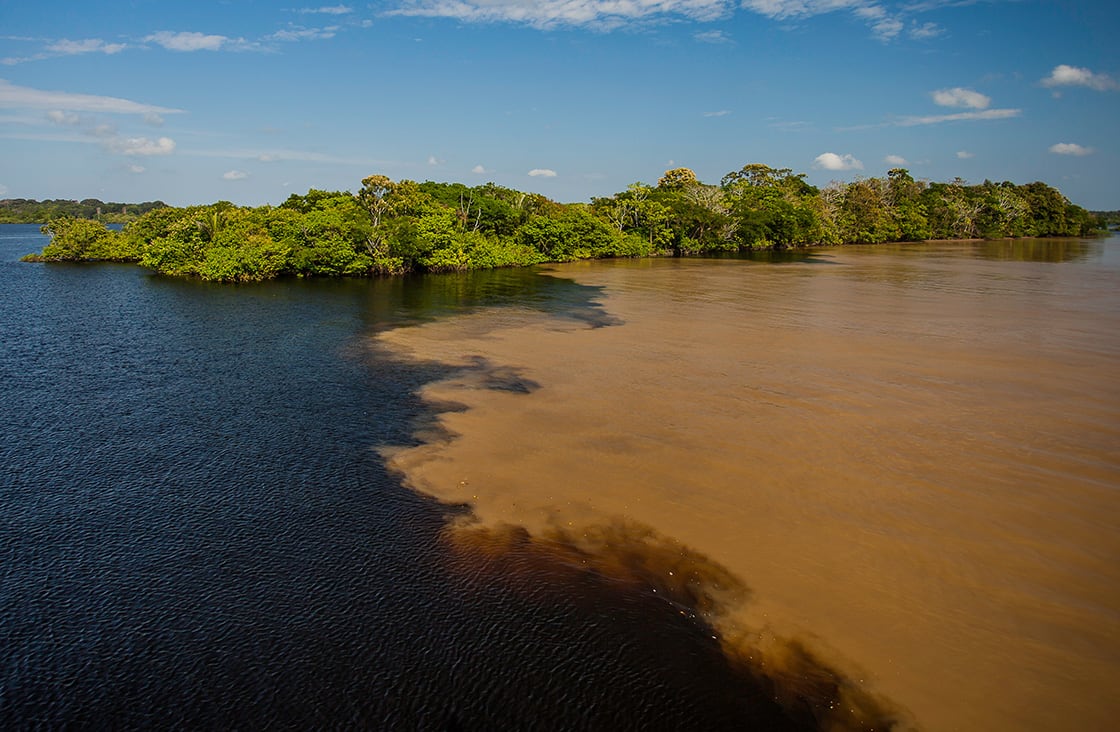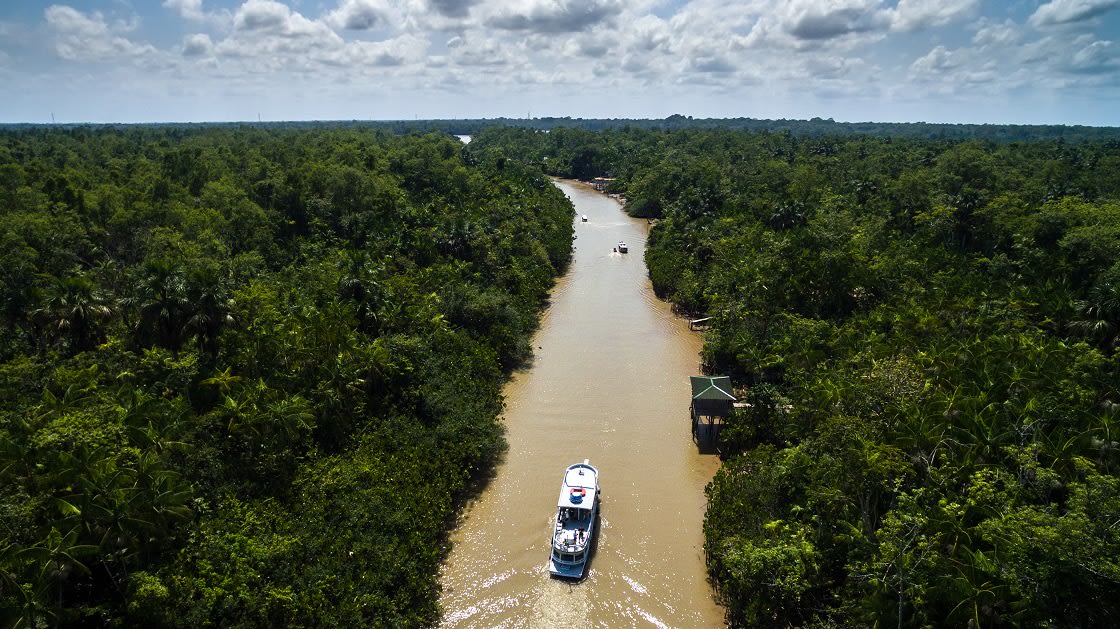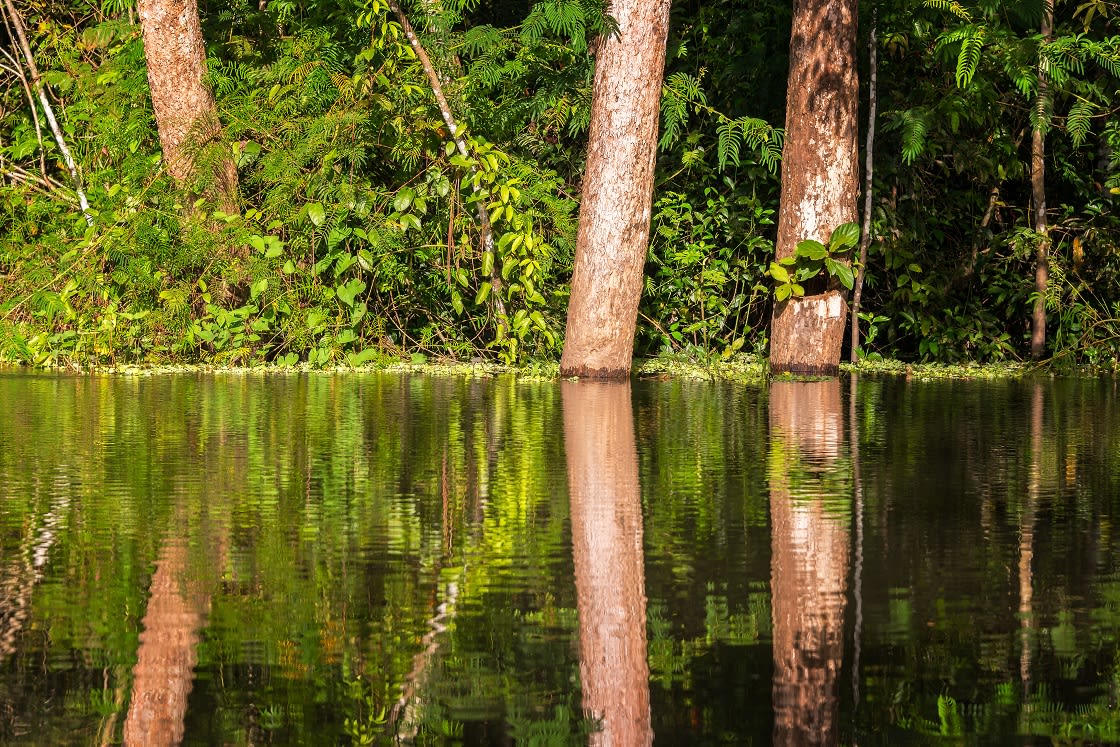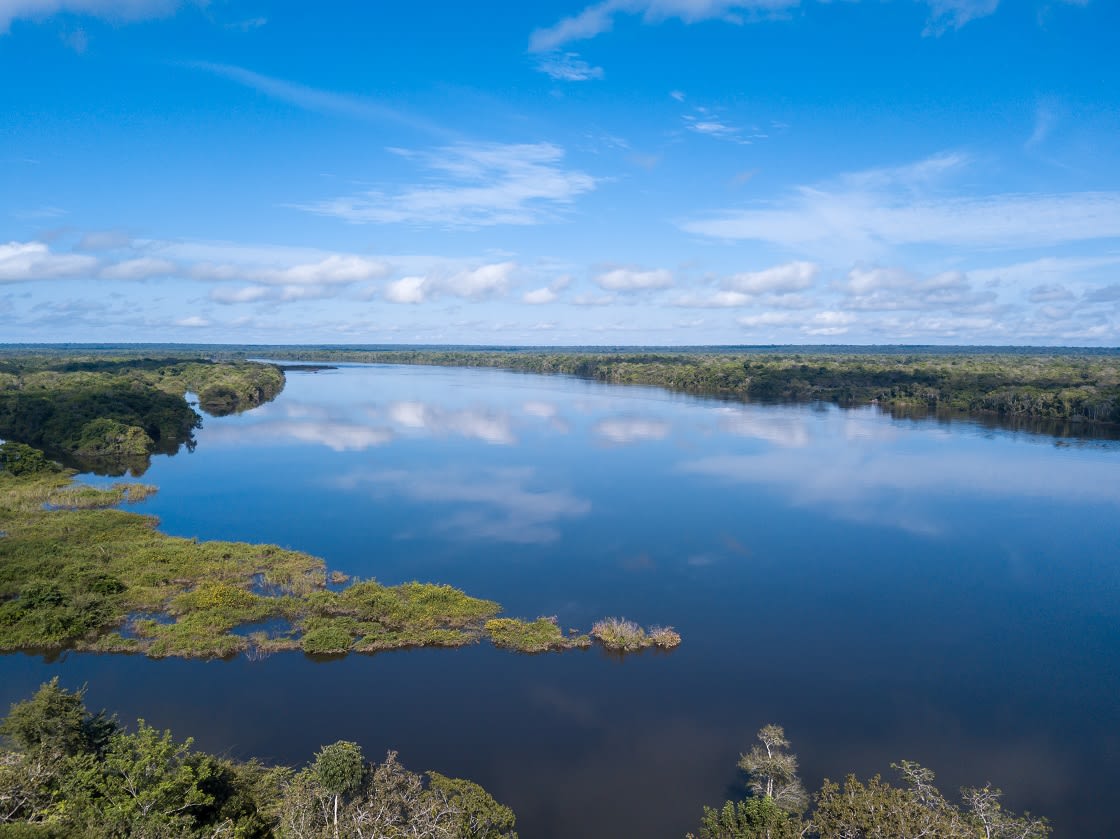
Home to the mighty River Amazon and its many tributaries, Amazonia is defined by its extensive network of waterways. But not all of its rivers are the same. Within the Amazon, there are three types of river: Blackwater, Whitewater and Clearwater. Why are some called whitewater, when they are in fact brown, and are they suitable for rafting? Are some called blackwater because of pollution? Here, we examine their differences, what causes them and what impact they have on the surrounding ecosystems.

Aerial View Of The Amazon River In Belem, Brazil
First-time visitors to the Amazon or other large tropical rivers are often shocked to see muddy brown, almost polluted-looking water. However, this color results not from sewage or pollution, but from the heavy sediment load of the water. Each day, tons of sediment are washed into rainforest rivers from the mountains, and from the run-off of surrounding forest areas, owing to heavy tropical rains. The sediment load is even greater where deforestation has left the soils unprotected and massive amounts of topsoil are eroded by the rains.
Despite their cafe-au-lait appearance, such tropical rivers are generally known as “whitewater” – or brown-water – rivers. Because whitewater rivers are often fed by a large number of acidic tributaries, they are relatively soft in terms of water hardness due to their relatively low mineral content, and they have a slightly acidic to neutral pH (6.3-7.0).
Whitewater tropical rivers are the typical form of large rivers in lowland tropical rainforests. Because such rainforests are generally flat with little elevation, large tropical rivers have little gradient and flow relatively lazily through them. The Amazon, for example, falls only 345 feet (105 m) from the Peruvian river port of Iquitos, a full 2,300 miles from the ocean. Thus the river descends at a rate of only 1.8 inches per mile (2.8 cm/km).
Some of the best-adapted animals to the low visibility of the muddy whitewater are river dolphins, which are found in the Amazon, Ganges, and Indus. River dolphins have very poor eyesight, and like oceanic dolphins rely on sonar for navigation and location of prey.
River dolphins are most abundant in the large open river channels, although during Amazonian floods they will range through the flooded forest areas.
Smaller tropical rainforest rivers are not so uniform in composition and in water flow as large tropical-forest rivers, which tend to be whitewater. There are two other water types found commonly in the tropical rainforest besides whitewater: blackwater and clear- or ‘blue-water’ – rivers.

View Of Trees Reflected In The Yanayacu River In The Pacaya Samiria Reserve, Peru
More common in tropical lowland forests than clearwater rivers are blackwater rivers, which as the name suggests, have a dark coffee color. This color results from the leaching of tannins from the decaying leaves of adjoining vegetation.
Blackwater rivers are also characterized by striking water clarity; so clear that visibility may exceed 30 feet (9 meters). However, after rainstorms, blackwater rivers can lose their typical clarity and color as sediment runs off from the surrounding forest. Within a few hours to a few days, the normal conditions return.
Chemically, blackwater rivers are very low in dissolved minerals and often have no measurable water hardness. The acidic, almost sterile water, with a pH between 3.5-6, keeps parasite and bacterial populations to a minimum. For this reason, blackwater rivers are considered some of the cleanest natural waters in the world, most often compared to “slightly contaminated distilled water.” The water chemistry of blackwater also inhibits the proliferation of insect larvae, so the forest around blackwater tends to have fewer mosquitos.
Surrounding some pure blackwater rivers are blackwater forests, which are different from conventional rainforests. The acidity of the water limits the number of tree species that can grow in the area near the river. The low tree diversity is responsible for a lower variety of insect species because insect species that would otherwise pollinate and feed upon other tree species have no opportunities in blackwater forests.
Coupled with the harsh water conditions of blackwater rivers, this results in considerably lower overall insect diversity than in other forests. Accordingly, the blackwater forest areas support fewer numbers of other animal species.
The soft, acidic conditions of blackwater rivers can be traced to their source: they originate in lowland tropical forests, where the ancient soils have no minerals to increase water hardness. Tannins released from decaying leaves increase acidity.
Because blackwater rivers are directly fed by runoff from the surrounding rainforest, the soils of which are generally nutrient-deficient, these rivers are nutrient-poor, and the surrounding floodplain areas are less suitable for cultivation than the floodplains of larger whitewater rivers like the Amazon. The nutrient deficiency of the soils along the shores of the Rio Negro makes the river known by Indians as the River of Hunger. Similarly, blackwater rivers support a lower bio-load than surrounding whitewater rivers, though they tend to have a tremendous diversity of fish species.
Fish have specially adapted to tolerate blackwater conditions. Many of the fish species that inhabit blackwater are best known outside the tropics for their popularity as aquarium fish. Discus, angelfish, Arowana, elephant nose fish, many gouramis, and cardinal tetras are a few examples of blackwater species kept as aquarium subjects. The brilliant, iridescent colors of many small, schooling species like cardinal tetras, are believed to aid the school in recognition of its members in the dark waters.
The Arowana is a large, elongated, eel-like fish that swims along the surface looking for prey. It is also known as the “monkey fish” for its leaping ability – reportedly up to six vertical feet – which it uses to catch its prey, including insects, small animals, and even young monkeys and sloths.
The Rio Negro in Brazil is one of the world’s largest rivers (five miles at its mouth) and the most famous blackwater river. In contrast to the whitewater Amazon (the Rio Solimoes at this point), which has its origins in the mountain valleys of the Andes, the tributaries of the Rio Negro rise in the ancient rock formations of the Guyana Shield and flow through white-sand rainforests.
The differences between the blackwater of the Rio Negro and the whitewater Amazon are readily apparent where the two rivers meet near Manaus, Brazil. The rivers run side by side, clearly distinct as separate white and black water, before blending together after several miles.

Drone Aerial View Of The Beautiful Xingu River On A Sunny Summer Day, Brazil
Clearwater or bluewater, rivers are so named for their clear water. Such waters are fairly common as creeks and rivers flowing through ancient rock but are not abundant in lowland tropical rainforest.
Clearwater rivers are mostly found in the highlands like Guyana and Brazilian shields of South America where mountain and cloud forests grow. Because of their elevation, and tendency to run over rock, clearwater rivers are often rapid or fast-flowing.
The Xingu River is one of the biggest and best-known clearwater rivers in the Amazon.
Clearwater rivers have a higher pH and tend to have some dissolved minerals, making the waters harder than both blackwater and whitewater rivers. There is not much-suspended matter because the rock formations are ancient and no longer erode in the current.
Due to their clarity and mineral content, some clearwater rivers support abundant plant growth. Additionally, algae grow vigorously on the rocky substrate supporting a variety of sucker-mouth catfish, another popular aquarium subject is commonly known as plecos.
While Rainforest Cruises aim to provide accurate and up-to-date information, we make no representations as to the accuracy or completeness of any information herein or found by following any link on this site. Rainforest Cruises cannot and will not accept responsibility for any omissions or inaccuracies, or for any consequences arising therefrom, including any losses, injuries, or damages resulting from the display or use of this information.




